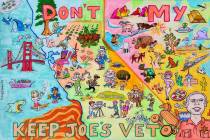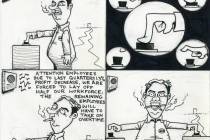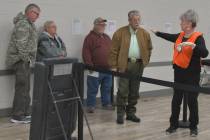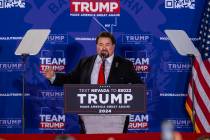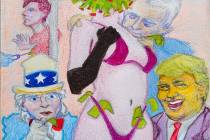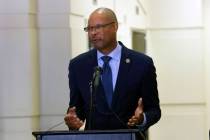Of lyrics and lawmaking
Ed Vogel of the Las Vegas Review-Journal last week made the case for a new state song of Nevada. For those who don’t know it (population in Nevada turns over so rapidly, it’s easy for long-time residents to take for granted the familiarity of State Things), the song is “Home Means Nevada” and it has been the Nevada anthem for 81 years.
It’s rarely sung the way it was written (more about that in a moment). It’s usually given a soft, melodic delivery. Unlike some anthems — notably the “Star Spangled Banner” — it’s easy to sing. Voice teachers say the music for the national anthem has wildly high and low ranges, the extremes making it a hurdle for even the best of voices.
It probably also didn’t help that the music wasn’t actually written for the words, which weren’t written to be lyrics. The words were shoehorned into an old English tune that really doesn’t match them.
“Home Means Nevada” does not have those difficulties and generations of children have found it easy to sing. In 1982 I heard a candidate for lieutenant governor, Tag Taggart, claim in his candidacy announcement that his children burst into the state song as they crossed the state line into Nevada after a vacation.
The state song, like many longstanding State Things, has received some competition in recent years. In 2001, Assemblymember Greg Brower successfully sponsored a bill creating a state march.
This kind of competition had precedent. In 1987, a group of children as a school project got a bill introduced to declare the Bristlecone Pine the Nevada state tree. As it happened, Nevada already had a state tree, the Pinon Pine. These kinds of school projects were all the rage at the time.
This particular one was a good opportunity for state legislators to give the students a real exposure to lawmaking by defeating the bill, since the students had made no case for displacing the Pinon Pine. But the lawmakers spinelessly decided to give Nevada TWO state trees, a situation that remains in place today.
There was another precedent, too. In the 1980s, San Francisco Mayor Dianne Feinstein called for making “I Left My Heart In San Francisco” by George Cory and Douglass Cross the city’s official song, which would mean displacing the city’s traditional song, “San Francisco” by Bronislau Kaper, sung by Jeanette MacDonald in the 1936 movie of the same name. City officials seem to love “I Left My Heart” but residents have long been lukewarm toward it. One reporter writing from San Francisco called it, “The one this storied city’s residents love to hate and hate to love.”
The city responded by making one song the city song and the other the city ballad.
Brower’s bill was intended to make “Silver State Fanfare” by Gerald Willis into the state march. What no one seemed to realize was that the state song, “Home Means Nevada,” IS a march. The sheet music of Bertha Raffetto’s song reads quite clearly, “Tempo di Marcia” — march tempo, though few people have ever seen the sheet music, so it is rarely sung that way.
When Raffetto wrote “Home Means Nevada,” the Comstock, Goldfield/Tonopah, and eastern Nevada copper mining rushes were past. Clark County’s growth was still in the future.
At the time, Reno was so dominant that Walter Van Tilburg Clark called it the “state-city.” However, Raffetto never mentions Reno. The only place names are the Truckee River and the “Kit Carson Trail,” whatever that is. (The Mormon Emigrant Trail is sometimes called the Carson Trail, so perhaps that is the trail meant.)
The Truckee reference may make the song too northern oriented to some ears, but if so they haven’t been particularly vocal. There have been few complaints about “Home Means Nevada” based on north/south issues.
The song has so little regionalism that it has transcended such things. Its language instead deals with the play of moonbeams in a glen, the colors of the western sky, the grey of the desert, and the “heart of the golden west.”
That’s more than can be said for the state soil (coarse-loamy, mixed, superactive, mesic Durinodic Xeric Haplocambids), the state precious gemstone (the Virgin Valley black fire opal), the state artifact (the tule duck decoy), and other State Things.
Dennis Myers is an award winning journalist who has reported on Nevada’s capital, government and politics for several decades. He has also served as Nevada’s chief deputy secretary of state.







